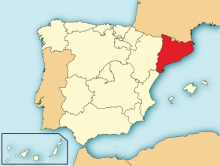You are here
Information by Autonomous Community
Catalonia
The regionalisation of climate scenarios by the Meteorological Service of Catalonia focused up to the year 2050 reveals a clear increase in average annual temperatures (up to 1.8°C), an increase in the number of tropical nights, reduction of days with frost, an increase in the year-on-year variability of precipitation levels and the maximum length of droughts (with periods of more than 100 days).
The Catalan Strategy for Adaptation to climate change 2013-2020 (Spanish acronym: ESCACC) drawn up by the Catalan Climate Change Office and passed by Generalitat de Catalunya in November 2012, analyses the 32 impacts that have been observed and the 31 that are anticipated on 11 natural systems and socio-economic sectors. It also proposes 182 adaptation measures.
In terms of the environment and as a resource, water is the element most vulnerable to impact. On a territorial scale, the Pyrenees (owing to the increase in temperature and the reduction of precipitation) and the coastal area, especially the Ebro Delta (due to rising sea levels and the lack of sediments and environmental flows) are the most vulnerable areas.




